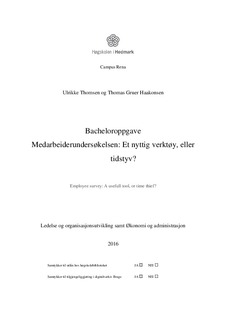| dc.contributor.author | Thomsen, Ulrikke | |
| dc.contributor.author | Gruer Haakonsen, Thomas | |
| dc.date.accessioned | 2017-01-26T11:56:33Z | |
| dc.date.available | 2017-01-26T11:56:33Z | |
| dc.date.issued | 2016 | |
| dc.identifier.uri | http://hdl.handle.net/11250/2428620 | |
| dc.description | Bachelor, 180 studiepoeng. | nb_NO |
| dc.description.abstract | Denne oppgaven er i utgangspunktet en studie om medarbeiderundersøkelser, og hvordan de gjennomføres i forhold til gitte oppskrifter på området. Vi hadde en mistanke om at ansatte ikke er godt nok representert i forarbeidet når en organisasjon planlegger en medarbeiderundersøkelse. I tillegg lurte vi på om etterarbeidet var godt nok ivaretatt, og hvilke forventninger ansatte har i forbindelse med medarbeiderundersøkelsen. Dette er bakgrunnen for vår problemstilling:
Hva er de ansattes syn og forventninger til medarbeiderundersøkelsen som Høyere Utdanning Midt benytter, og hvordan er denne gjennomført i forhold til de gitte anbefalinger? For å tydelig kunne svare på denne todelte problemstillingen så vi det nødvendig å konstruere tre delproblemstillinger. De tar for seg hvorvidt de ansatte ser en nytteverdi ved gjennomføring av en medarbeiderundersøkelse, om de ansatte mener de har tilstrekkelig påvirkningskraft i forarbeidet med medarbeiderundersøkelsen, og hvilke forventninger de har til den. Vi utførte fem intervjuer med ansatte ved en høyere utdanningsinstitusjon, hvor vi også gjennomførte et informantintervju. Svaret fra intervjuobjektene var delte, men hovedsakelig så de ansatte nytten av en medarbeiderundersøkelse. De vi intervjuet mente at resultatene åpnet for en friere diskusjon i etterarbeidsfasen rundt det psykososiale og fysiske arbeidsmiljøet. Det fremkom av både informantintervjuet og intervjuobjektene at ledelsen ikke har satt opp etterarbeidet slik de gitte rammer tilsier at er beste måte å gjør det på. I tillegg kommer det tydelig frem at det skaper forventninger når man gjennomfører en medarbeiderundersøkelse. Fra tilbakemeldingene om hvorvidt intervjuobjektene var enig i hvordan medarbeiderundersøkelsen blir gjennomført, viser funnene fra noen av intervjuobjektene at den med fordel kan forbedres, mens andre mener den er god nok. Slik vi anser resultatene burde utdanningsinstitusjonen lage en egen medarbeiderundersøkelse, som er mer rettet mot den enkelte avdeling. Etterarbeidet burde også følges opp på en mer systematisk måte, da det kommer frem store forskjeller mellom de ulike avdelingene om hvordan etterarbeidet gjennomføres. Intervjuobjektene som kom fra én avdeling var svært fornøyde, mens intervjuobjekter fra andre avdelinger var mindre fornøyde. Men stort sett er det mangler på tvers av de geografiske områdene utdanningsinstitusjonen strekker seg over. | nb_NO |
| dc.description.abstract | Engelsk sammendrag (abstract): This paper is a study on employee surveys, and how they are implemented in accordance with given recipes within the subject. We suspected that employees are not adequately represented in the working process when an organization is planning an employee survey. In addition, we wondered if the supplementary work was sufficiently attended to, and what expectations employees have in regards to the employee survey. This is the background to our paper: What are the employees' views and expectations of the employee survey in Higher Education Central, and how is this implemented in relation to the given recommendations? To clearly answer this two-part issue, we saw it necessary to construct three sub-questions. These present whether the employees see a value in completing an employee survey. The sub-question also present whether the staff believe they have sufficient influence in the preparatory work with the employee survey, and what expectations they have of it. We conducted five interviews with employees at a higher education institution, where we also conducted an informant interview. The response from the interviewees were divided, but mainly did the employees see the benefits of an employee survey. Those we interviewed felt that the results opened for a discussion in the post-production phase around the psychosocial and physical work environment. This study shows that both the informant interview and interviewees felt like the management didn’t work with the results from the employee survey, the way the subject’s recipe is recommended for employee surveys. In addition, it is clearly stated that there exist expectations when conducting an employee survey. From the feedback around whether interviewees agreed on how the employee survey should be conducted, the findings of some of the interviewees was that it can advantageously be improved, while others believe it is good enough. We think the results show that the educational institution should create a separate employee survey, which is more geared towards the individual departments. The supplementary work should also be pursued in a more systematic manner. The results show substantial differences between the various departments about how the supplementary work should be carried out. Interviewees who came from one department are delighted, while interviewees from other departments were less satisfied. But mostly the supplementary work is lacking across the geographies spans in the educational institution. | nb_NO |
| dc.language.iso | nob | nb_NO |
| dc.subject | medarbeiderundersøkelse | nb_NO |
| dc.subject | deduktiv tilnærming | nb_NO |
| dc.subject | empiri | nb_NO |
| dc.subject | fenomenologisk design | nb_NO |
| dc.subject | kvalitativ metode | nb_NO |
| dc.subject | case-design | nb_NO |
| dc.subject | Employee Survey | nb_NO |
| dc.subject | Case Study | nb_NO |
| dc.subject | Phenomenological | nb_NO |
| dc.subject | Qualitative Design | nb_NO |
| dc.title | Medarbeiderundersøkelsen: Et nyttig verktøy, eller tidstyv? | nb_NO |
| dc.title.alternative | Employee survey: A usefull tool, or time thief? | nb_NO |
| dc.type | Bachelor thesis | nb_NO |
| dc.subject.nsi | VDP::Samfunnsvitenskap: 200::Statsvitenskap og organisasjonsteori: 240::Offentlig og privat administrasjon: 242 | nb_NO |
| dc.source.pagenumber | 64 | nb_NO |
